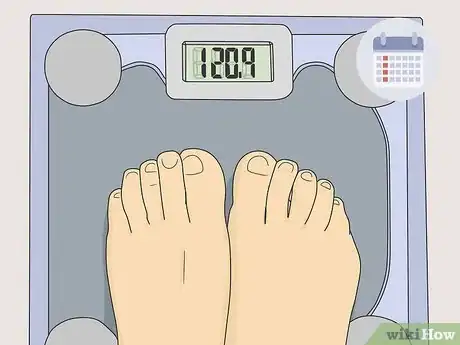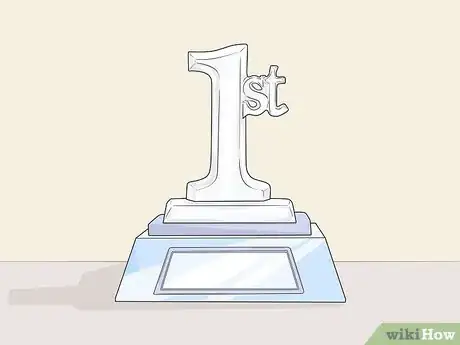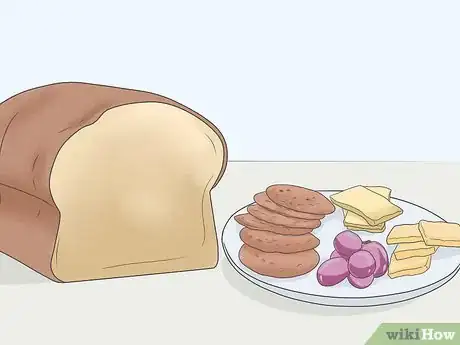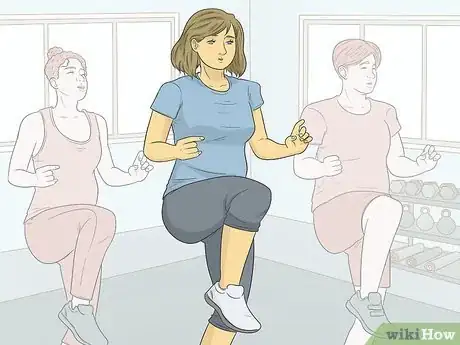This article was co-authored by wikiHow Staff. Our trained team of editors and researchers validate articles for accuracy and comprehensiveness. wikiHow's Content Management Team carefully monitors the work from our editorial staff to ensure that each article is backed by trusted research and meets our high quality standards.
wikiHow marks an article as reader-approved once it receives enough positive feedback. In this case, 100% of readers who voted found the article helpful, earning it our reader-approved status.
This article has been viewed 510,935 times.
Learn more...
The Biggest Loser makes weight-loss a competition, which motivates people to work harder to achieve their goals. You can easily set up your own weight-loss competition at work. Start by organizing how the challenge will work. Get your boss to approve the competition, then outline the rules and sign up contestants. Then do an initial weigh-in and then a weekly weight check to track contestant success. Declare a winner at the end of the challenge. To offer more support along the way, you can also organize group workouts, potlucks, and support meetings.
Steps
Organizing the Challenge
-
1Obtain permission from supervisors and bosses. Since this is a workplace activity, everything has to be approved by management. Before signing up contestants or starting any competitions, approach your boss and explain the idea. Make sure they give you permission to run the contest at work.[1]
- Having management on your side can also help advertise and fund the competition.
- Don’t hide any details from your boss. Explain the competition and all the activities you’ll be doing. This will avoid any potential problems as the contest goes on.
- If your boss doesn’t approve, you can still design a competition that takes place outside of work. Just make sure no activities happen at your workplace to avoid violating any rules.
-
2Ask HR to make this competition part of the company wellness program. Some company health insurance plans include special stipends for health programs at work. Your HR rep should know the details of any plans like this, if they exist. After getting the boss’s permission to run the contest, ask HR if there are any extra funds or incentives in the company health plan to help.[2]
- The company health plan may even offer some money to fund the contest or the prize money. Ask your HR rep if there is a provision like this in the company health plan.
Advertisement -
3Determine contribution levels if you’re offering a monetary prize. Most competitions like this offer prizes for the top losers. An easy way to fund these prizes is for each contestant to pay a small contribution as a sign-up fee. This contribution then goes into the prize fund. Make the contribution level something small that everyone can afford, like $10 or $20. Collect these fees at the start of the competition.[3]
- Some competitions offer prizes for weekly winners, and some offer a lump prize for the final winner. Decide if you want to do weekly prizes, a large final prize, or both.
- If someone can’t pay the entry fee, don’t block them from participating. They can still take part in the competition and activities. Just make them ineligible for the prize money.
- You could also ask the company to match the amount of money you raise for the final prize. If you make this request, have a good pitch ready. Explain how this will improve the health and synergy at the company, and that funding will make the competition even better.
-
4Set the competition to last 2–3 months. This time limit sets a good pace for contestant weight loss. It gives them enough time to get started on a new weight-loss regimen and drop pounds at a healthy speed. It also discourages quick crash dieting, which is unhealthy and unsustainable.[4]
- Healthy, sustainable weight loss goals are about 2 pounds (0.91 kg) per week. Encourage your contestants to meet this goal for a healthy weight loss pace.[5]
- Starting the contest around January is a good time because many people make weight-loss resolutions for New Year's.
-
5Consider counting the percentage of body weight lost rather than just pounds. There are 2 main measurements that weight-loss competitions use. The first is overall weight loss, which is just the total pounds (kg) that a person lost. The second measures the percentage of body weight lost. Both are important for weight loss, so consider counting both measures in determining winners.[6]
- For instance, Michael may weigh 200 pounds (91 kg) and John may weigh 300 pounds (140 kg). At the end of the competition, Michael lost 20 pounds (9.1 kg), or 10% of his bodyweight, and John lost 25 pounds (11 kg), or 8%. John won in overall weight loss, but Michael won in percentage lost.
- Consider offering 2 prizes, 1 for most overall weight lost and 1 for highest percentage.
-
6Sign up contestants. With the organization and permissions in place, now start spreading the word and getting people interested. Hang flyers, send emails, and talk to your coworkers to get everyone excited about the contest. As people sign up, record their names and collect their contest fee for the prize fund.[7]
- Remember to set a start date for the competition so everyone knows when to start their weight-loss programs.
- Make email lists or social media groups for contestants to stay in contact and updated. Make any announcements about the competition on this platform.
- Never pressure anyone to sign up for this contest. People may be self-conscious about their weight, and you could create a hostile work environment by pressuring people.
-
7Organize teams if you’re doing a collaborative weight loss challenge. Some biggest loser challenges make teams, and the winners are decided by which team lost the most weight together. For an added layer of teamwork, consider making this a team activity. Take all your contestants and organize them into teams for the competition.[8]
- The best way to decide on teams is randomly placing people in their assigned team. This avoids arguments and accusations of favoritism for the contest.
- You can use the old-fashioned method of pulling names out of a bucket, or use software to randomly assign contestants to a team.
- Be aware that team weight-loss challenges could lead to resentments if one team member isn’t working as hard as the others. If you know your workplace has a lot of people who aren’t good sports, an individual challenge may be better.
Running the Competition
-
1Design a spreadsheet to track everyone’s weight loss. Stay organized throughout the competition to accurately track everyone’s weight loss. Use a spreadsheet or similar software to plug in everyone’s weekly weight loss. Then use this table to add up everyone’s weight-loss total.[9]
- The simplest way to do this is to have everyone’s name in one column, their starting weight in another, and their weekly weigh-in total in each column after that.
- If you’re better with spreadsheets, plugging in formulas to add up everyone’s total weight loss and the percentage of their body weight lost gives you more accurate results.
-
2Do an initial weigh-in for all the contestants in a private area. Start the competition by getting everyone’s baseline weight. Get an accurate scale and find a private location for the weigh-in, like an empty conference room. Then have each contestant come in individually for their weigh-in. Remember to record all the numbers in your spreadsheet.[10]
- Stay consistent with how you take everyone’s weight. For instance, everyone should either remove their shoes or keep them on. Also have everyone take off heavy clothes like jackets. Keep these parameters constant for everyone each week.
-
3Respect everyone's privacy about their weight. People are often sensitive about their weight, even when they participate in an activity like this contest. Make sure that for all the weigh-ins, only you (or the person measuring the weight) and the contestant are in the room. Respect people and don’t talk about their weight outside of the weigh-in. There are several other ways to keep people's weight a secret from other participants.[11]
- To declare a winner, only say the total weight a person lost, not their actual weight. For more privacy, only report on the percentage that each person lost. Other participants won't be able to figure out a person's original weight or the weight they lost from this information.
- If someone wants their weight kept completely private, accommodate that. You could, for example, just say what place they're in for the competition. If the board only says that Mary is in 3rd place without a weight amount, this keeps the competition going without violating anyone's privacy.
- If you do a team competition, keeping everyone's weight private is easier. Just report on the total weight lost by the entire team. This way, no one knows the specific amount each person lost.
-
4Take weekly weigh-ins to measure contestants’ success. Pick a day of the week and time that works for everyone. Keep this time consistent each week and bring everyone in for a weigh-in. Conduct these weigh-ins the same way you conducted the first one. Go to a private area, call each contestant in individually, and record their weight.[12]
- Inform each contestant of how they’re doing. If they’d like some feedback on how they could do a better job of reaching their goals, have some weight-loss tips ready to give them.
- Remember to keep the weighing parameters consistent. Don’t have contestants remove their shoes one week and leave them on the next week. This taints your results.
- Never shame anyone if they didn’t lose weight or even gained a little during one week. Life is stressful and not everyone is able to keep up with the program every single week. Don’t discourage people.
-
5Let contestants back out if they want to. Some people have trouble staying up on their weight loss every week. If anyone wants to drop out, allow them to. Don’t pressure or shame them into staying in the competition. Thank them for their participation and effort.[13]
- Unless you made some sort of announcement at the beginning of the competition that the entry fee was non-refundable, refund them their money. This avoids any resentment on the employee’s part.
-
6Declare a winner after the time is up. After the time for the competition passes, do a final weigh-in. Record everyone’s weight and add up their total weight loss for the competition. Use those figures to determine your winner or winners for the competition.[14]
- If you’re presenting a group prize, add up the total weight loss for each group member. If you’re awarding a prize for greatest percentage of body weight lost, make sure you calculate this correctly.
- Either announce the winner after the final weigh-in, or consider doing a closing awards ceremony to announce the winners.
- Remember to congratulate everyone on their success and commitment. The point of the contest is for contestants to get healthier, not just win prizes.
Designing Other Activities
-
1Schedule a weekly support meeting for contestants. Losing weight takes a lot of dedication, and it can be a tough process. All your contestants might need some moral support at one time or another. Build a community and schedule regular support meetings for all contestants. Let everyone share their stories, successes, and struggles with losing weight. That way, all contestants can help support each other to complete the contest.[15]
- Letting other people into these meetings who aren’t in the contest could help build some more community overall at work.
- You could also bring in speakers or fitness coaches during these meetings for more feedback and encouragement. Ask your company to help fund these speakers.
-
2Host a healthy food potluck. Dieting is an important part of losing weight. Encourage all your contestants to eat healthier by having an event where everyone brings in only healthy food. This helps build community and also gives contestants ideas for their own healthy meals.[16]
- Have contestants also post the recipes for their healthy meals. Then the contestants can make their own batches.
- Consider making this a friendly competition and having contestants vote on the tastiest healthy food.
-
3Organize group workouts. Some people are more motivated to exercise when other people are around. Help your contestants stay motivated by planning group exercises where everyone can partake. Schedule 1 or 2 workouts a week so you don’t overwhelm your contestants.[17]
- A group jog after work or on the weekend is a simple way to encourage group workouts.
- Allow others in the office to partake as well. You might get some new contestants to sign up after they see the community that you’re building.
- Remember to keep these workouts low-intensity. Everyone is at different fitness levels, so don’t exclude people who can’t keep up.
Warnings
- People who are already at a healthy weight should not take part in a Biggest Loser contest.⧼thumbs_response⧽
References
- ↑ https://smallbusiness.chron.com/host-biggest-loser-competition-work-39574.html
- ↑ https://www.frugalconfessions.com/financial-health/weight-loss-competition/
- ↑ https://smallbusiness.chron.com/host-biggest-loser-competition-work-39574.html
- ↑ https://www.livestrong.com/article/359849-ideas-for-biggest-loser-in-the-workplace/
- ↑ https://www.cdc.gov/healthyweight/losing_weight/index.html
- ↑ https://www.livestrong.com/article/359849-ideas-for-biggest-loser-in-the-workplace/
- ↑ https://smallbusiness.chron.com/host-biggest-loser-competition-work-39574.html
- ↑ https://www.livestrong.com/article/359849-ideas-for-biggest-loser-in-the-workplace/
- ↑ https://www.syracuse.com/cny/2011/02/how_to_run_your_own_biggest_loser_contest_so_weight_loss_program_builds_health_camaraderie.html
- ↑ https://smallbusiness.chron.com/host-biggest-loser-competition-work-39574.html
- ↑ https://smallbusiness.chron.com/host-biggest-loser-competition-work-39574.html
- ↑ https://smallbusiness.chron.com/host-biggest-loser-competition-work-39574.html
- ↑ https://www.frugalconfessions.com/financial-health/weight-loss-competition/
- ↑ https://smallbusiness.chron.com/host-biggest-loser-competition-work-39574.html
- ↑ https://www.livestrong.com/article/359849-ideas-for-biggest-loser-in-the-workplace/
- ↑ https://www.entrepreneur.com/article/304250
- ↑ https://www.entrepreneur.com/article/304250














































































